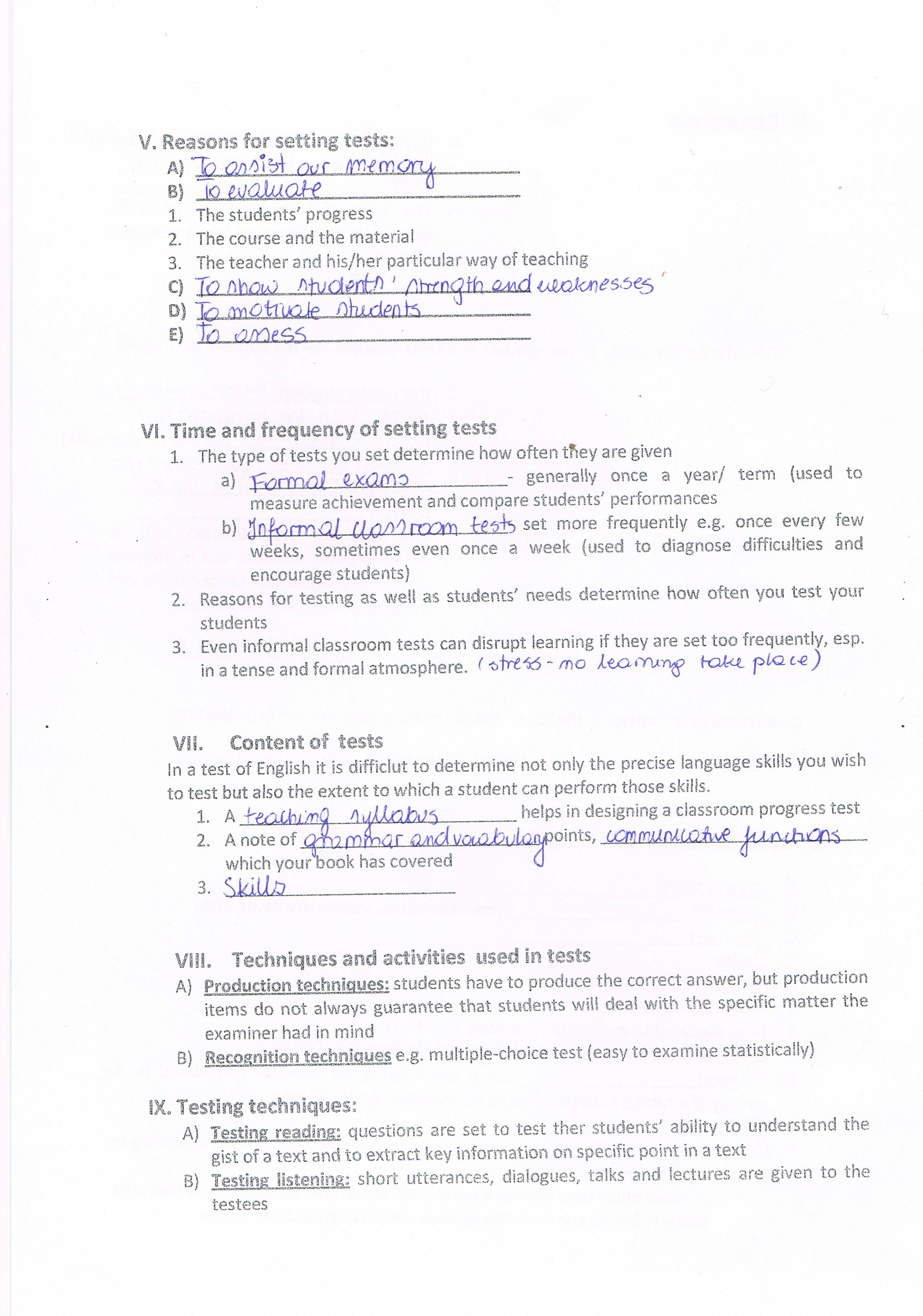CCF20110611�056

V. Reasons for setting tests: A)
B) J£_&ZOk*2źfL
1. The students' progress
2. The course and the materia!
3. The teacher and his/her particislar way of teaching
o)
£) Ih^siine^
tirndenfo.
VI. Time and frequerscy of setting tests
1. The type of tests you set determine how often tftey are given
a) farm/i! <IX(2(Y)0__- generaliy once a year/ term (used to
measure achievement and compare students’ performances
b) *jr formuł Hę/)'}rrrxr\ łefrK set morę frequently e.g. once every few weeks, sometimes even once a week (used to diagnose difficuities and entourage students)
2. Reasons for testing as well as students’ needs determine how often you test your students
3. Even informal ciassroom tests can disrupt learning if they are set too frequently, esp. in a tense and forma! atmosphere. (- /no Xeo.rrur^? hzU<i pto. t-e )
VII. Content of tests
In a test of English it is difficlut to determine not oniy the precise ianguage skiISs you wish to test but also the extent to which a student can perform those skills,
1. A fysiLbi'/nQ ĄjlJLnhfS___helps in designing a ciassroom progress test
2. A notę of (^fy? CCnifriUfU-CO^M1 kA<iub£fis___
which your faook has covered <j ^
3- SkiLb___
VIII. Teehniejues and aetivitles used in tests
A) Productlom teehniaues: students have to produce the correct answer, but production items do not always guarantee that students will deai with the specific matter the examiner had in mind
B) Reeognifiora łechniaues e.g, multiple-choice test (easy to examine statistically)
IX. Testing techniques:
A) Testing reading; questions are set to test ther students' ability to understand the gist of a text and to extract key Information on specific point in a text
B) Testing iistemng: short utterances, dialogues, taiks and iectures are given to the testees
Wyszukiwarka
Podobne podstrony:
International Journal of Computer Science & Engineenng Survey (UCSES) Vol.6, No.2, April 2015 Th
24 Project Management for PhDs est to plan well. The new work, for example setting up one’s own busi
Temporary Mobile Subscriber Identity (TMSI) This number is sometimes used instead of the IMSI. One r
45213 jff 012 THE MODERN IDEA - JUDO FOR FUN There is no reason for continuing this attitude in Amer
CCF20100223�003 cavity than for Polish o, (2) it is morę open, i.e. the space between the back of th
ccf20110606�009 BONUS A 15-year-old boy comes to the office for a sports participation physical exam
CCF20110611�019 ^/hat aro tho rritoria for ronrcohook awalmtion? m - A«rvtó -nś ■ background of the
CCF20110611�054 kjtaktehh^ JkćOllfy. 8. objective tests overcome this problem of marker reliabllity,
CCF20101208�001 ^6)* X ~ 3L(/rjJ c f(V) r JO kltt/Jl - -
CCF20110105�027 jcPHlPlBJCSaD. L* t). ^0Sx L 1 H L/ pro-m^dti- 1 / H •■•- L L l L l. h jl
CCF20110202�005 co/ f/^yozyjTT l PccJu cc 1 JL ■30.JJ..... CMfyOlUM-O.LUAj jjOclet £C <DGU£ S&l
ccf20110606�009 BONUS A 15-year-old boy comes to the Office for a sports participation physical exam
więcej podobnych podstron